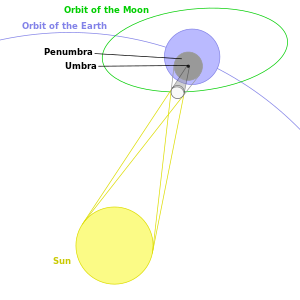 Geometry of a Total Solar Eclipse
Geometry of a Total Solar EclipseAs seen from the Earth, a solar eclipse occurs when the Moon passes between the Sun and the Earth, and the Moon fully or partially covers the Sun as viewed from some location on Earth. This can only happen during a new moon, when the Sun and Moon are in conjunction as seen from Earth. At least two, and up to five, solar eclipses occur each year; no more than two can be total eclipses. Total solar eclipses are nevertheless rare at any particular location because totality exists only along a narrow path traced by the Moon's umbra.
Many people will travel to remote locations to observe a central solar eclipse (see Types below). The solar eclipse of August 11, 1999, in Europe helped to increase public awareness of the phenomenon, which apparently led an unusually large number of journeys made specifically to witness the total solar eclipse of October 3, 2005, and of March 29, 2006.
The last total eclipse was the solar eclipse of July 22, 2009; the next will be the solar eclipse of July 11, 2010. The recent solar eclipse of January 15, 2010, was an annular eclipse (see Types below); the next annular eclipse will occur on solar eclipse of May 20, 2012.

A total solar eclipse is a natural phenomenon. Nevertheless, in ancient times, and in some cultures today, solar eclipses have been attributed to supernatural causes or regarded as bad omens. A total solar eclipse can be frightening to people who are unaware of their astronomical explanation, as the Sun seems to disappear in the middle of the day and the sky darkens in a matter of minutes.
No comments:
Post a Comment